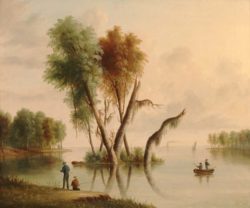Robert Brammer
Itinerant landscape painter Robert Brammer opened a portrait studio in New Orleans in 1842.

Courtesy of Roger H. Ogden Collection
Mississippi Panorama. Brammer, Robert (artist)
Irish artist Robert Brammer, who primarily painted landscapes, was active in New Orleans between 1842 and 1853. Most of his existing works are southern landscapes, likely inspired by the time he spent in Kentucky, Louisiana, and Mississippi. Brammer’s Louisiana scenes are oil paintings that often depict large oak trees draped in Spanish moss on a riverbank or in a tranquil marsh setting.
Brammer was born in Waterford, Ireland, but little is known about his early life, his professional training as an artist, and the circumstances that brought him to America. His name appears in Wheeling, West Virginia, in 1837, where he promoted his services as a “professor of drawing and landscape painting.” After a brief stay in Wheeling, the artist arrived in Louisville, Kentucky, between 1838 and 1839. In 1840 he became associated with the German artist Augustus Von Smith. They painted large-scale scenes together, including Oakland House and Race Course, Louisville (ca. 1840). In 1842, they went to New Orleans, and for a short time shared a studio on St. Charles Avenue, where they painted portraits.
Brammer worked alongside several other itinerant artists while living in New Orleans. In 1843, the Daily Picayune commented on a painting by Brammer that was in the studio of Theodore Sidney Moïse (1808-1885). This notice led Brammer to collaborate with Moïse and artist James Henry Beard (1814-1893): Brammer completed various backgrounds for their monumental portrait paintings. His professional association with Moïse continued, and in 1844 the Daily Picayune published a complimentary article on Brammer, Moise, and Trevor Thomas Fowler (1800-1871), noting that the three artists worked in the same building on St. Charles Avenue, “a few doors above Canal Street.”
Brammer’s own work flourished during the late 1840s and into the 1850s. By 1847, he had a studio on the corner of Camp and Canal streets. That same year, the Commercial Times reported that he had returned from a trip to the north, where his “portfolio [was] stocked with sketches of the most prominent features of natural scenery in our country.” Though he painted scenes of the northern states, mainly his southern scenes survive today. During this productive period of his artistic career, he completed such picturesque landscapes as Mississippi Panorama (ca. 1850), Swamp Scene (1852), Fishing in Kentucky near Louisville (1853), and Louisiana Landscape (not dated).
Little is known about Brammer’s patrons, specific commissions, or exhibition history, though in 1851 the Daily Orleanian noted that art patrons “have had frequent opportunities of seeing and admiring his chef d’ouvres at the residence of our friend, ex-Alderman Collins.” Only two years after this article was published, Brammer died in Biloxi, Mississippi. The artist kept a summer home in Biloxi, and it is thought that he often traveled to the Gulf Coast from New Orleans. It is known that during his career, he painted a Mississippi coastal scene, Rounding Pass Christian Point (not dated). Newspapers from the Gulf South chronicled his death and praised his talent, writing that Brammer’s paintings “were the very embodiments of poetry.”
